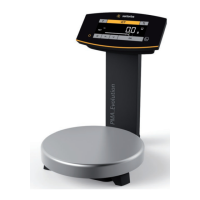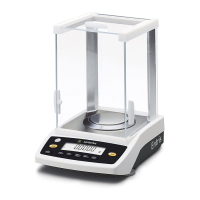Do you have a question about the Sartorius Extend Series and is the answer not in the manual?
| Category | Scales |
|---|---|
| Brand | Sartorius |
| Series | Extend Series |
| Calibration | External |
| Display | LCD |
| Interface | RS-232 |
| Power Supply | AC Adapter |
| Protection Class | IP43 |
General safety guidelines, handling precautions, and potential hazards.
Explanation of symbols used throughout the manual for warnings and instructions.
Guidelines for storing and shipping the balance/scale to prevent damage.
Steps for unpacking the equipment and listing the supplied items.
Recommendations for choosing a suitable location and initial setup.
Procedure for acclimating the balance to ambient conditions before use.
Step-by-step guide for assembling components for different draft shield types.
Instructions for connecting the balance to AC power using adapters and country-specific cords.
Identification and explanation of the balance's display and control keys.
How to ensure the balance is level for accurate weighing using adjustment feet.
Procedure for weighing samples using the port on the bottom of the balance.
Step-by-step demonstration of performing a basic weighing operation.
Explains the purpose of calibration and conditions for performing it.
Details on performing external calibration, especially for legal metrology.
Procedure for internal calibration using the built-in motorized weight.
Explains the role of keys when navigating the configuration menu.
Demonstrates how to navigate menus, using language setting as an example.
Provides a structured view of parameter settings across different menu levels.
Details on using the counting program to determine part quantities.
How to use the program to obtain weight readouts in proportion to a reference weight.
Guide for using the calculation program to determine weight per unit area or gsm.
Procedure for weighing unstable samples and calculating averages.
Instructions for weighing components to a defined total and printing individual weights.
How to add successive weight values to a total exceeding balance capacity.
Steps to change displayed weight units to different application units.
Method for determining the density of solid substances using buoyancy.
Details on device information, ID texts, and date/time for printouts.
Explains keys for transferring header and outputting footer data.
Describes the serial interface for connecting peripherals and data transmission.
Details default settings for transmission rate, parity, handshake, etc.
Explains formats for 16 and 22 character data output, including special codes.
Lists common error codes, their causes, and suggested solutions.
Information on service contracts and professional repair requirements.
Guidelines for cleaning the balance housing, keypad, and stainless steel parts.
Details on built-in calibration, AC power, power consumption, and ambient conditions.
Compares specifications like weighing capacity, readability, and dimensions across different models.
Lists available calibration weights, their classes, and order information.
Details available accessories like printers, remote displays, and data cables.












